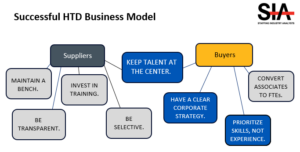It is time for businesses and contingent workforce programs to reimagine their talent-sourcing approach. With an unemployment rate of 3.8% and about 8.8 million job openings, the US has an unemployed person per job opening ratio of 0.7 to one. And with an ongoing “silver tsunami” of retiring baby boomers, that is only going to tighten.
Meanwhile, advances such as artificial intelligence applications are accelerating the demand for new skill sets and roles for their development, implementation and support. Tech skills are a common thread in many talent and skills shortages across industries. Some market research indicates that as soon as a new hire is onboarded, the skills they need have changed. Hence, the pace of change is a key disruptive factor in the transformation we are currently experiencing in today’s talent marketplace.
The traditional talent sourcing options for both full-time hiring and temporary staffing are not keeping the required pace for change. While alternative sourcing channels such as outsourcing, statement-of-work projects and services, direct sourcing and on-demand talent platforms are making important contributions, there is not yet a complete solution.
This is where a reimagined approach comes into play. One such strategy worth exploring is leveraging the talent already in house. Investing in upskilling/reskilling their capabilities — and enhancing their career path — can help the organization meet its needs and requirements.
Click on chart to enlarge.

Alternative talent/skills gap solutions can be developed externally with a partner or executed internally.
Source: SIA’s Recruit-Train-Deploy (or Hire-Train-Deploy) Model research report
Alternative Talent/Skills Sourcing Methods
Training in terms of upskilling or reskilling is a strategic investment of these alternative talent/skills sourcing methods, and in many cases, one is developing skills and talent required versus attempting to buy it on the open marketplace. This type of talent sourcing/development initiative requires a clear corporate strategy with all relevant parties aligned (hiring managers, procurement, HR) about the importance of this skills/talent sourcing model and what you are trying to accomplish.
This recent SIA research also indicates that talent is the centerpiece of all these alternative talent sourcing methods. We are talking about teaching real people real skills. There’s a very real human element to this that cannot be ignored, or this sourcing and talent development model will not work. Current or prospective employees will need to commit to this learning and training. Transformation, whether on a personal level or a corporate level, is hard. Working to make sure that the people involved are excited, engaged and on board with the process will go a long way toward smoothing that. These kinds of new approaches to talent development are especially important right now — because the traditional way of sourcing skills and talent isn’t working as effectively to meet current business requirements. Although there might just be a willing mood as many workers are looking for what’s next; as some research has shown, large percentages of employed talent are potentially looking for a new job.
The biggest barrier to greater adoption of upskilling/reskilling talent is entrenched, traditional talent sourcing expectations and a lack of understanding about how to use recruit-train-deploy options. There are numerous important benefits for buyers that should make it a relatively easy sell to try this alternative skills/talent sourcing model:
- It reduces costs by minimizing the need to pay premiums for external consultants, experience or one-off training.
- It makes costs predictable and provides a reliable talent pipeline.
- Such a program can be tailored to the specific needs and goals of the business.
- It provides quick and efficient scalability, filling short-term needs or long-term growth strategies.
- It reduces unplanned employee turnover.
- It provides more control over the quality of workers placed in new roles.
Getting Started
As a sage industry executive noted, “Understanding the problem is always the first key step to solving most challenges.” Understanding the problem is always first step to solving most challenges. But there are also some concrete steps that business and talent leaders can take to start reimagining their talent pipelines and sourcing methods:
- Empower talent leaders to make changes to the traditional hiring process, from removing degree requirements to forging partnerships with community organizations and training partners.
- Build alternative pathways that expand the talent pool your company can access, such as tech industry hire-train-deploy models or apprenticeships, which create smoother pathways into high-demand roles.
- Prepare for future skills now by pinpointing the headcount, roles and skill profiles needed to set your team and company up for success in an AI-driven economy.
Businesses are not going to address and resolve the current and expanding skills/talent gap challenge by fighting with competitors in a limited pool of skills/talent. This is a costly approach that is recently producing unfavorable results. Reimagining skills/talent sourcing methods and channels just might help keep pace with the technological and AI-driven changes businesses face. Simultaneously, this skills/talent development approach to the skills/talent gap might move current workers from thought of joining the Great Resignation to a great participation in the retention experience for all involved.
For further insight on this topic, review the recent SIA webinar discussion on Reimagining Talent Pipelines: Upskilling, Reskilling, and Hire-Train-Deploy online.









